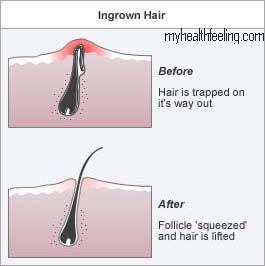Psuedofolliculitis Barbae or more commonly known as ingrown hair may also occur on the pubic region. In fact, ingrown pubic hair is widespread as the hair in this region is thicker and curlier than hair in other zones of the body. Ingrown hair happens when the hair is cut below the level of the skin and grows underneath the epidermis, not clearing through the hair follicle. There are cases of ingrown hair in which the curly hair bends towards the direction of the skin and grows inward, leading to inflammation and irritation as manifested by rashes or red bumps on the skin surrounding the hair.
Ingrown Pubic Hair Causes
Ingrown pubic hair arises, generally, because of improper hair grooming like shaving against the direction of the hair growth or plucking the hair from underneath the skin. Though these are the most common causes, tweezing, waxing and depilatory products when used improperly can also give you unwanted, and even painful ingrown hair.
Genes also play a role in the occurrence of ingrown hair. If your hair is dark, bristly and wavy, then you are more susceptible to having ingrown hair. The coarser and curlier your hair is, the higher the probability of getting ingrown hair not only on the pubic region.
Ingrown pubic hair bumps pictures
Prevention of Ingrown Pubic Hair
The following are some tips to prevent the occurrence of ingrown pubic hair.
• Shave properly.
It is best not to shave at all. But if you must, shave less frequently, and when you do, make sure to do it right.
First, trim your pubic hair using scissors or clippers with shortest guard by pulling the hair away from your body. Soak yourself in warm water to make the hair follicle and skin softer. Next, apply shaving cream to the area to be shaved. This will further soften the hair for easier shaving. As there are many individuals who are allergic to some shaving cream products, do a patch test first. Using a hypo-allergenic shaving cream is recommended. Choose a sharp, single bladed razor, since unlike multi-bladed razors, single blades do not shave too close to the skin.
Hold the skin taut, and then shave following the direction of the hair growth. Go over the same area with two to three strokes only as irritation might occur when you shave the area too many times. For every instance you shave, do it in the same manner. This will make your hair straighter when it grows back. Weekly shaving is enough; any more will make the hair too short and will make it prone to ingrown pubic hair.
If shaving causes itching, apply witch hazel. Aloe vera will also heal and keep your skin moisturized.
• Be careful when waxing.
Waxing generally results to the hair breaking off underneath the skin, resulting to ingrown hair. Even if you can withstand the pain involved in waxing the region, it is not recommended. But if you insist, do follow the instructions in the packaging to the letter.
• Try depilatories.
This is a better method as it somewhat melts the hair- all you have to do is wipe it. Ingrown pubic hair is avoided, plus it takes the hair three to six weeks to reappear.
However you like to remove hair from your pubic region, taking care of your skin will help prevent ingrown hair. Here are some tips for skin care.
• Exfoliate. Get rid of dead skin cells and any hairs that may have been trapped. A sponge, washcloth or loofah could be used to gently scrub the pubic area. There are also products specific for the pubic area. These have glycolic or salicylic acids, so better perform a patch test to see if you are sensitive to any of the ingredients.
• Moisturize. Unscented lotions are best. Apply on skin (make sure to keep it outside of your body) after taking a bath.
• Watch what you wear. Tight-fitting underwear, shorts or pants constantly scrape the skin, which may then lead to the hair to grow back into the follicle. Choose loose fitting clothes.
• Have a bump-fighter on hand. There are products that combat ingrown hair before they get worse. If you notice beginnings of a red bump, use them to fight pubic ingrown hair head-on.
Ingrown Pubic Hair Treatment
If you already have ingrown pubic hair, do not shave, wax or use depilatories before it is fully healed to avoid infection. Here are some things you can do to treat ingrown hair.
• Soften the affected area using a hot flannel compress. Apply this 3 times per day. You may also go into sauna or hot tub to open the pores of the skin and let loose any trapped hairs.
• Exfoliate to loosen the skin and draw out the ingrown hair.
• If the ingrown pubic hair is infected, use tweezers sterilized in hydrogen peroxide to remove the hair. After which, apply hydrogen peroxide and aloe vera to prevent further infection.
• Finally, wear loose fitting underwear to prevent worsening the problem.
There you have it, the causes, prevention and treatment tips to help you deal with ingrown pubic hair.

